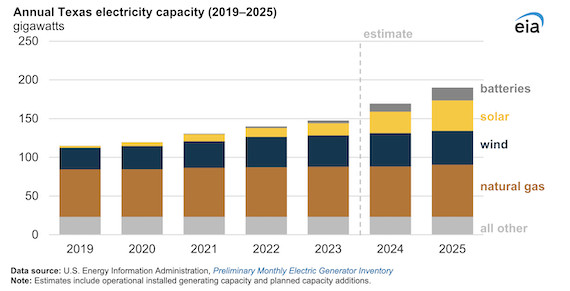
Climate Victory: Texas Solar Power Growing so Rapidly, it is Reducing demand for Fossil Gas
Ann Arbor (Informed Comment) – The far right Texas legislature, dominated by Republicans in the back pocket of the fossil fuel industry, has done what it could to promote fossil gas as a power source for electricity generation. Just last summer, it passed a bill that offered companies bonuses for connecting new gas plants to the electricity grid and offered 3% loans to developers in this industry. In so doing, these ignorant cretins guaranteed further deadly carbon dioxide emissions, which are wrecking the planet.
Soon after the elected, unindicted felons passed their dirty bill, Texas was hit with an unprecedented string of 100° F. days amid one of the state’s worst and longest heat waves, accompanied by severe drought. The state also faces sea level rise along the coasts, storm surges, more powerful hurricanes, flooding, and severe winters caused by the polar vortex exacerbated by climate change. Not to mention that it experienced just last month among the worst and largest wildfires in U.S. history.
While government is powerful and economic incentives can affect economic activities, this pitiful effort to prop up the dying fossil fuel industries appears to resemble most the frenetic to and fro of a chicken that has been beheaded. A lot of energy expended just before a certain demise.
Exhibit A is a new report by the Energy Information Agency that shows how rapidly solar power is overtaking fossil gas in the state.
Wind farms produce the most renewable energy in Texas, but solar is making rapid strides, alongside vastly increased battery storage. Solar power generation in the Lone Star state has already overtaken that in California, which is saying something.
From the winter of ’22-’23 to the past winter, ’23-’24, solar power generation in Texas increased by a whopping 35%. This increased solar power generation allowed the state to use less fossil gas in the middle of the day. Yes, solar is coming on so strong in Texas that it is already displacing fossil gas.

“Solar Hero v. Gas Monster,” by Juan Cole, Digital, Dream/ Dark Fantasy/ IbisPaint, 2024.
Utility-scale solar now generates about a third as much power (32k GWh) as wind (108k GWh) in Texas. For the moment, wind is holding steady and only growing slowly as a power source.
Solar, in contrast, is set to grow by leaps and bounds over the next two years. Texas now has 16 gigawatts of solar power, but in ’24 and ’25 there are plans to add 24 gigawatts of solar net summer capacity to the grid.
Texas ended 2023 with 5.6 gigawatts of battery storage, but there are plans to add 13 gigwatts of battery storage to the electricity grid in the next couple of years.
Julian Spector at Canary Media explains that Texas’ ERCOT incentivizes entrepreneurial renewables:
- “Unlike California, Texas does not award specific contracts to ensure sufficient grid capacity; instead, the price spikes from moments of scarce supply are meant to incentivize private developers to build power plants and make money. Developers have found that acquiring land, obtaining permits and connecting to the grid is easier in Texas than in California’s regulatory regime. The payoffs can be huge, both for developers and residents. For developers, rapidly responding batteries are well suited to making money off the sudden swings in ERCOT’s increasingly renewables-inflected markets.”
How delicious that the market and technological innovation are allowing renewables companies to outflank the corporate welfare socialism of Texas’ conservative legislators. Watch the top of the below graph moving left to right. It is showing the future:

Source: US Energy Information Administration
The combination of solar and batteries is important because after midday, solar generation begins declining. Consumers get home from work and put a big strain on the grid from 6 pm to 8 pm, when solar goes offline. Some of this shortfall is taken up by wind farms, since the winds pick up in the evening. But much of it is covered by fossil gas peaker plants, which come online to substitute for the fading solar generation.
But if excess solar power has been stored in batteries, then you can release it back into the grid as the sun sets, instead of turning to the fossil gas peaker plants. Since the latter emit a great deal of carbon dioxide as they come online, the batteries save a lot of CO2.
There are also plans for a further 3 gigawatts of wind generation by the end of 2025.
The long and the short of it is that solar growth is already so great that it is cutting down on the need for fossil gas in the Texas grid during some hours of the day and during the summer. Doubling solar capacity and combining it with a tripling of battery storage will make even greater inroads into fossil gas.
There is no point in getting a 3% loan or a bonus from the state government to build a fossil gas plant if you will nevertheless go bankrupt. Hence there are only plans to add 3 gigawatts of fossil gas capacity to the Texas grid over the next two years, only a fifth of what is planned for solar and only a fourth of what is planned for battery storage. Somebody is being left in the dust.

No comments:
Post a Comment
Note: Only a member of this blog may post a comment.